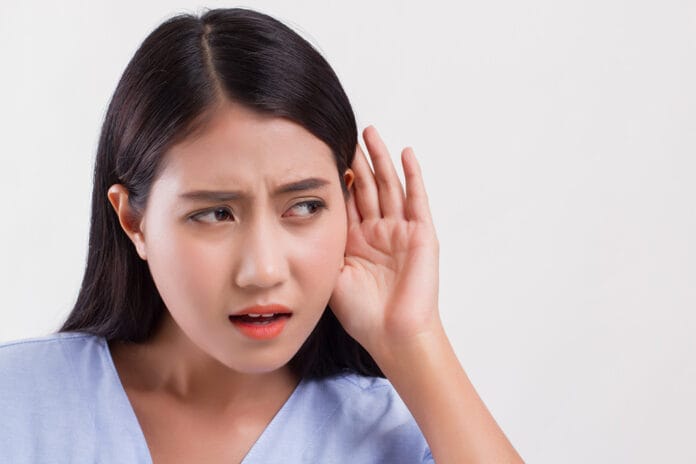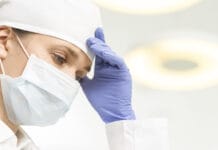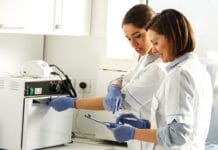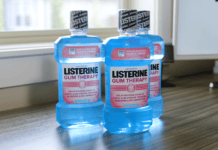Dental professionals have always been masters of personal protection equipment (PPE). Despite being covered from head to toe in gowns, gloves, masks, head coverings, and loupes, many still fail to equip themselves with a vital piece of PPE – earplugs.
When noise levels are taken into consideration, it is often in environments where loud sounds are prominent, such as factories, airports, and construction sites. Many employers require ear protection while on the job. The Occupational Safety and Health Administration (OSHA) states in 29 CFR 1910.95(c) that when a worker’s noise exposure equals or exceeds an eight-hour time-weighted average of 85 dBA, the employer shall implement a hearing conservation program.1
High-pitched sounds are typically heard in dental offices throughout a normal eight-hour workday. Contributing factors include low- and high-speed handpieces, high-volume suction, ultrasonic cleaners, lathes, and sonic and piezo scalers.2
Noise-Induced Hearing Loss
In order to hear, a series of events that change sound waves in the air into electrical signals must occur. During this series of events, vibrations form a traveling wave among hair cells that rest on a partition within the cochlea called the basilar membrane. Hearing loss occurs when noise levels damage or kill these particular hair cells. Unfortunately, these hairs do not grow back.3
For years, studies have shown that dental professionals are at high risk for noise-induced hearing loss (NIHL), a type of sensorineural hearing loss (SNHL). SNHL is the loss of hearing after prolonged exposure to environmental noise, which results from damage to the inner ear or auditory nerve. NIHL is permanent and irreversible. It is, however, 100% preventable.4
Studies show that hearing loss ranks as the second most work-related illness/injury and that, in the United States, hearing loss affects over 25% of the population.2
The effect of lower noise levels (dental drill) over a longer period of time is equivalent to the effect of loud noise levels (explosions) in a short period of time. Noise levels are the intensity of sounds at a given time and are measured in decibels (dB). The National Institute for Occupational Safety and Health (NIOSH) and the U.S. Environmental Protection Agency (EPA) measure noise levels as time-weighted average exposures over periods of time (dBA).5
In order to reduce the potential hazard of hearing loss, NIOSH recommends that hearing protection be worn when exposed to noises over 85 dBA. NIOSH also states that if an individual is continuously exposed to 85 dBA over an eight-hour work shift, they will have reached 100% of their daily noise dose.3 Dental professionals are at increased risk for NIHL because of repeated exposure to high-frequency noises.6 Dental professionals are exposed to these sounds repeatedly throughout the day, several days a week, for years.
Noisy Environment
Noise levels can be measured with a sound level meter (SLM). If this device is not available, smartphone apps that measure noise levels can be used as a supplement. In fact, NIOSH even developed an app of its own to help promote hearing health.5
Dental equipment that can create NIHL include:2
- Low-speed handpiece: 70 to 74 dB
- High-volume suction: 86 to 89 dB
- Ultrasonic cleaner: 91 dB
- Lathe trimmer: 61 to 96 dB
- Magnetostrictive ultrasonic scaler: 84 to 98 dB
- High-speed handpiece: 88 to 103 dB
- Piezoelectric ultrasonic scaler: 107 dB
While the topic of hearing loss in dentistry is gaining attention, it is not a new discovery. In fact, the American Dental Association has recommended hearing protection in the dental operatory since 1974.2 Studies show that dentists are 50% more likely to suffer from hearing loss than the general public.7 Compared to medical doctors, another study states that dentists’ hearing loss and tinnitus rates are doubled.8 One study conducted in a group of dental clinics reported that 21% of the dental professionals reported hearing-related issues after hire.9
Protection Against Hearing Loss
Because hearing loss is often gradual, it can be easy to ignore or not easily noticed. Early warning signs include having difficulty hearing others during a conversation or increasing the television volume. Other symptoms may include difficulty hearing certain frequencies, particular syllables, and difficulty hearing in noisy environments.4
Tinnitus (the ringing, buzzing, or roaring in the ears) is another common early symptom. While this symptom can subside, it sometimes remains constant and can subsequently create a decrease in mental and physical health and sense of well-being. Unfortunately, for some, tinnitus can become so unbearable it has led to life-ending means to escape.7,8 Tinnitus can be experienced by both short and long-term exposures. Tinnitus resulting from short-term exposure is often temporary; however, long-term exposure results in permanent damage.2
Dental professionals have several options for ear protection in the dental operatory. While traditional foam earplugs are the cheapest form of protection, they muffle out most all sounds, making it difficult to communicate with others − not to mention that they are often uncomfortable. Studies show that this is the most common reason employees avoid ear protection.2
Over-the-counter, non-custom, noise-attenuation earplugs are an affordable option that does not completely block out all noise but reduces sound evenly. This particular option is often used by concertgoers. This earplug can also be made custom by an audiologist who would need to make an impression of the ear to create an earplug that fits securely and is more comfortable.4
The best option, yet the most expensive, is electronic earplugs. Equipped with a small microchip, these small earplugs compress higher-level damaging sounds while maintaining an “open ear” response, thus enabling clear communication.2
In Closing
Our hearing is valuable, enabling us to communicate efficiently with our patients. So why not protect it? After all, aren’t we notorious for preaching prevention to our patients? Once incorporated, it will bear no more burden or feel no different from the other forms of PPE we equip ourselves daily.
Before you leave, check out the Today’s RDH self-study CE courses. All courses are peer-reviewed and non-sponsored to focus solely on pure education. Click here now.
Listen to the Today’s RDH Dental Hygiene Podcast Below:
References
- PPE Selection – Hearing Protection. (n.d.). Occupational Health and Safety Administration. www.osha.gov/SLTC/etools/shipyard/standard/ppe/general_ppe/hearing_protection.html
- Dentistry’s Deafening Silence. (n.d.). The American Academy for Oral & Systemic Health. https://www.aaosh.org/connect/dentistrys-deafening-silence
- Kardous, C., Themann, C.L., Morata, T.C., Lotz, W.G. (2016, February 8). Understanding Noise Exposure Limits: Occupational vs. General Environmental Noise. Centers for Disease Control and Prevention. https://blogs.cdc.gov/niosh-science-blog/2016/02/08/noise/
- Noise-Induced Hearing Loss. (n.d.). Hearing Loss Association of America. https://www.hearingloss.org/hearing-help/hearing-loss-basics/noise-induced/
- What Noises Cause Hearing Loss? (2022, November 8). Centers for Disease Control and Prevention. https://www.cdc.gov/nceh/hearing_loss/what_noises_cause_hearing_loss.html
- Safety Tips to Prevent Hearing Loss. (n.d.). American Dental Association. https://www.ada.org/resources/practice/wellness/safety-tips-to-prevent-hearing-loss
- Prutsman, J. (n.d.). Hearing Loss and Tinnitus Among Dentists. Sound Relief Hearing Center. https://www.soundrelief.com/hearing-loss-and-tinnitus-in-dentists/
- Murray, I.D. Hearing Loss and Tinnitus Among Dentists. The Hearing Journal. 2020; 73(1): 10,12,13. DOI: 10.1097/01.HJ.0000651540.52366.f5
- Elmehdi, H.M. Noise Levels in UAE Dental Clinics: Health Impact on Dental Healthcare Professionals. Journal of Public Health Frontier. 2013; 2(4): 189-192. DOI:10.5963/phf0204002











